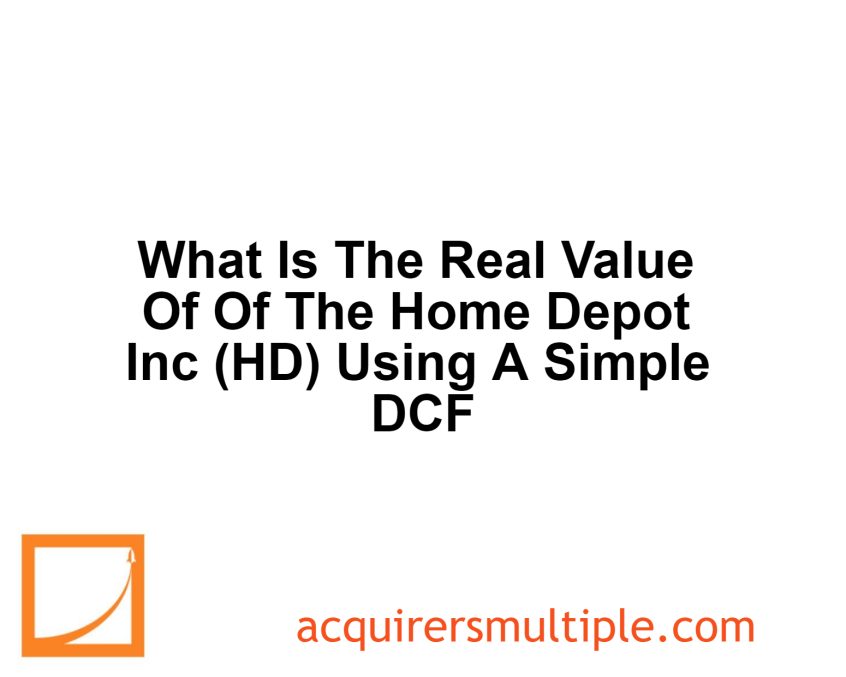As part of a new series, each week we’re going to conduct a DCF on one of the companies in our screens. This week the stock is The Home Depot Inc (HD). We currently have the stock on an Acquirers Multiple of 16.20. The stock is currently priced at $330.55.
Profile
Home Depot is the world’s largest home improvement specialty retailer, operating more than 2,300 warehouse-format stores offering more than 30,000 products in store and 1 million products online in the United States, Canada, and Mexico. Its stores offer numerous building materials, home improvement products, lawn and garden products, and decor products and provide various services, including home improvement installation services and tool and equipment rentals. The acquisition of distributor Interline Brands in 2015 allowed Home Depot to enter the maintenance, repair, and operations business, which has been expanded through the tie-up with HD Supply (2020). Moreover, the addition of the Company Store brought textile exposure to Home Depot’s lineup.
Inputs
- Discount Rate: 7%
- Terminal Growth Rate: 3%
Forecasted Free Cash Flows (FCFs)
| Year | FCF (billions) |
|---|---|
| 2023 | 15.6 |
| 2024 | 17 |
| 2025 | 18.4 |
| 2026 | 19.8 |
| 2027 | 21.2 |
Terminal Value
Terminal Value = FCF * (1 + g) / (r – g) = 545.9 billion
Present Value of Terminal Value
PV of Terminal Value = Terminal Value / (1 + WACC)^5 = 389.22 billion
Present Value of Free Cash Flows
Present Value of FCFs = ∑ (FCF / (1 + r)^n) = 74.67 billion
Enterprise Value
Enterprise Value = Present Value of FCFs + Present Value of Terminal Value = 463.89 billion
Net Debt
Net Debt = Total Debt – Total Cash = 40.44 billion
Equity Value
Equity Value = Enterprise Value – Net Debt = 423.45 billion
Per-Share DCF Value
Per-Share DCF Value = Enterprise Value / Number of Shares Outstanding = $419.26
Conclusion
| DCF Value | Current Price | Margin of Safety |
|---|---|---|
| $419.26 | $330.55 | 21.16% |
Based on the DCF valuation, Home Depot is currently undervalued. The DCF value of $419.26 per share is significantly higher than the current market price of $330.55. Margin of Safety is 21.16%.
It is important to note that the valuation is based on a number of assumptions, and these assumptions could change in the future. As a result, it is important to do your own research before making an investment decision.
For all the latest news and podcasts, join our free newsletter here.
Don’t forget to check out our FREE Large Cap 1000 – Stock Screener, here at The Acquirer’s Multiple:





8 Comments on “What Is The Real Value Of The Home Depot Inc (HD) Using A Simple DCF”
Guys – great concept but a couple points on the maths. You haven’t explicitly mentioned your growth assumption, which would be super useful. Also, you dont seem to have worked out the present value of the Terminal Value, you’ve just added the Terminal value as is to the PV of the FCFs, which i think has overstated the intrinsic value of the stock. Either way great idea and thanks!
Thanks Max. I think it’s important to note that DCF valuations are subjective. There is no single right way to do it. A lot depends on the assumptions I’ve made. You can spend hours on valuation but in order to keep the DCF process simple, I typically look at the company’s WACC, which is currently around 8%. Additionally, Aswath Damodaran often says if he didn’t have time to do all his calcs to work out his discount rate, he would just use 8%. In terms of terminal growth rate, I typically use growth rates based on historical inflation rates and GDP growth rates of around 2-4%. I’ve updated the PV of the Terminal Value.
Not specifically about HD’s DCF — what is the source of forecasted FCFs?
Hey Steve. I think it’s important to note that forecasting free cash flows is subjective. There is no single right way to do it. A lot depends on the assumptions I’ve made. You can spend hours on valuation but in order to keep the DCF process simple, I typically look at the company’s WACC, which is currently around 8%. Additionally, Aswath Damodaran often says if he didn’t have time to do all his calcs to work out his discount rate, he would just use 8%. In terms of terminal growth rate, I typically use growth rates based on historical inflation rates and GDP growth rates of around 2-4%. Then I stick it all in a spreadsheet.
Can we take a look at the XLS for this DCF, please?
Not at this stage, but happy to answer any questions on it.
Thank you. Johnny. Can you list the key input variables for the model, please?
In addition to the WACC calculation inputs, and balance sheet inputs. Main inputs are Discount Rate 7%. Terminal Growth Rate 3%. WACC 7%.